Leadership Styles and Traits
VerifiedAdded on 2023/04/21
|9
|2168
|270
AI Summary
This document discusses various leadership styles and traits, including situational, transformational, and servant leadership. It explores the effectiveness of different leadership styles in different scenarios and provides examples of influential leaders. The document also includes a personal leadership profile and highlights the importance of understanding one's strengths and weaknesses as a leader. Overall, it provides valuable insights into leadership and its impact on organizational performance.
Contribute Materials
Your contribution can guide someone’s learning journey. Share your
documents today.
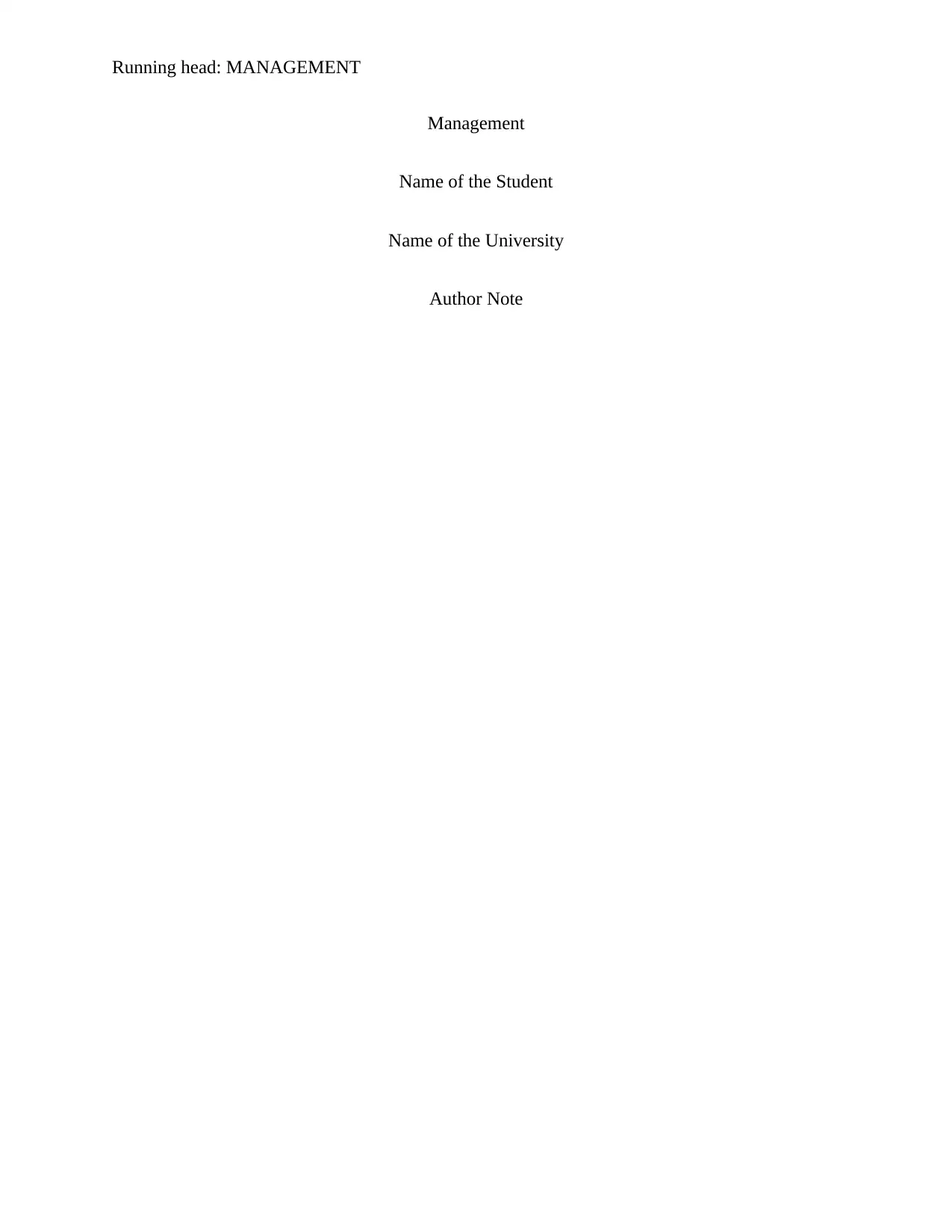
Running head: MANAGEMENT
Management
Name of the Student
Name of the University
Author Note
Management
Name of the Student
Name of the University
Author Note
Secure Best Marks with AI Grader
Need help grading? Try our AI Grader for instant feedback on your assignments.
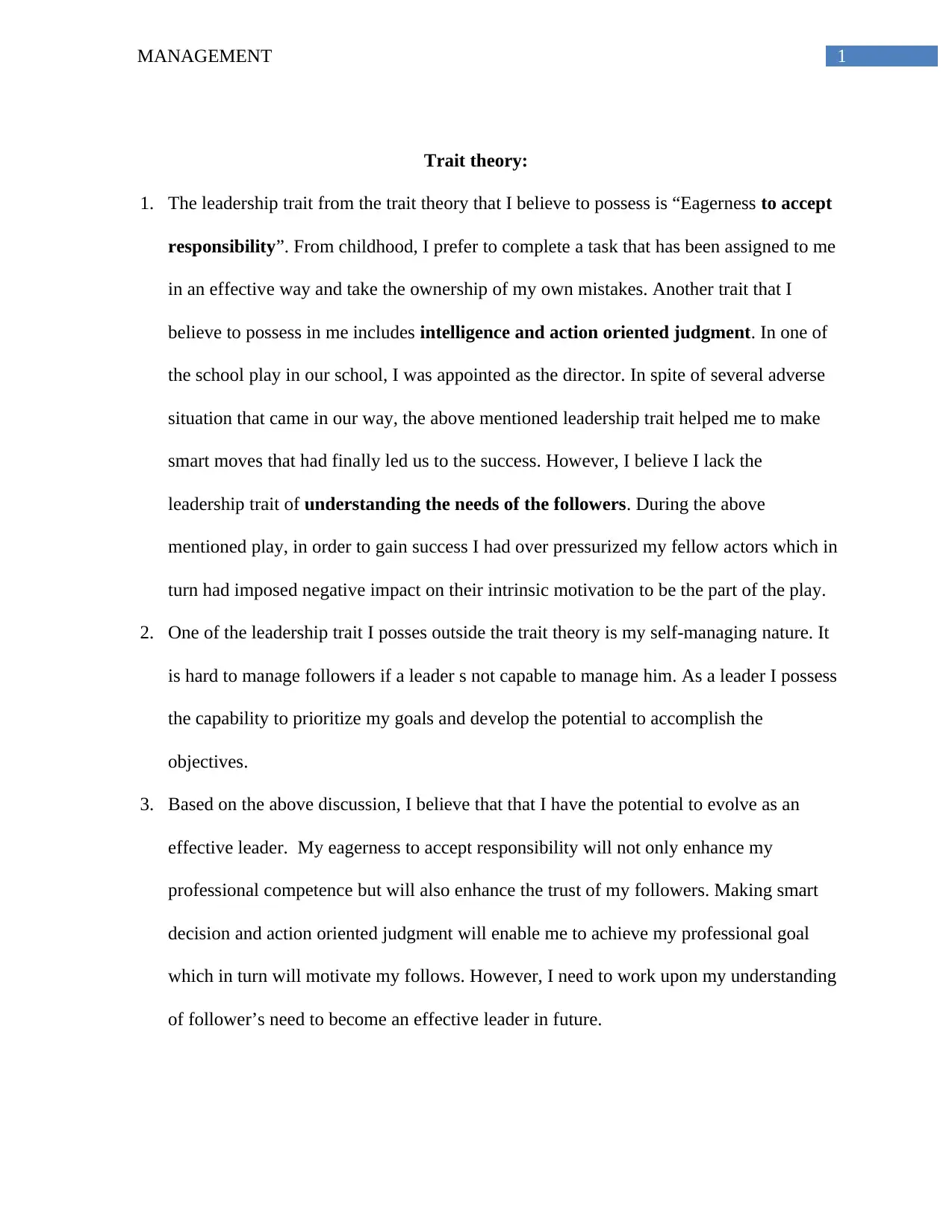
1MANAGEMENT
Trait theory:
1. The leadership trait from the trait theory that I believe to possess is “Eagerness to accept
responsibility”. From childhood, I prefer to complete a task that has been assigned to me
in an effective way and take the ownership of my own mistakes. Another trait that I
believe to possess in me includes intelligence and action oriented judgment. In one of
the school play in our school, I was appointed as the director. In spite of several adverse
situation that came in our way, the above mentioned leadership trait helped me to make
smart moves that had finally led us to the success. However, I believe I lack the
leadership trait of understanding the needs of the followers. During the above
mentioned play, in order to gain success I had over pressurized my fellow actors which in
turn had imposed negative impact on their intrinsic motivation to be the part of the play.
2. One of the leadership trait I posses outside the trait theory is my self-managing nature. It
is hard to manage followers if a leader s not capable to manage him. As a leader I possess
the capability to prioritize my goals and develop the potential to accomplish the
objectives.
3. Based on the above discussion, I believe that that I have the potential to evolve as an
effective leader. My eagerness to accept responsibility will not only enhance my
professional competence but will also enhance the trust of my followers. Making smart
decision and action oriented judgment will enable me to achieve my professional goal
which in turn will motivate my follows. However, I need to work upon my understanding
of follower’s need to become an effective leader in future.
Trait theory:
1. The leadership trait from the trait theory that I believe to possess is “Eagerness to accept
responsibility”. From childhood, I prefer to complete a task that has been assigned to me
in an effective way and take the ownership of my own mistakes. Another trait that I
believe to possess in me includes intelligence and action oriented judgment. In one of
the school play in our school, I was appointed as the director. In spite of several adverse
situation that came in our way, the above mentioned leadership trait helped me to make
smart moves that had finally led us to the success. However, I believe I lack the
leadership trait of understanding the needs of the followers. During the above
mentioned play, in order to gain success I had over pressurized my fellow actors which in
turn had imposed negative impact on their intrinsic motivation to be the part of the play.
2. One of the leadership trait I posses outside the trait theory is my self-managing nature. It
is hard to manage followers if a leader s not capable to manage him. As a leader I possess
the capability to prioritize my goals and develop the potential to accomplish the
objectives.
3. Based on the above discussion, I believe that that I have the potential to evolve as an
effective leader. My eagerness to accept responsibility will not only enhance my
professional competence but will also enhance the trust of my followers. Making smart
decision and action oriented judgment will enable me to achieve my professional goal
which in turn will motivate my follows. However, I need to work upon my understanding
of follower’s need to become an effective leader in future.
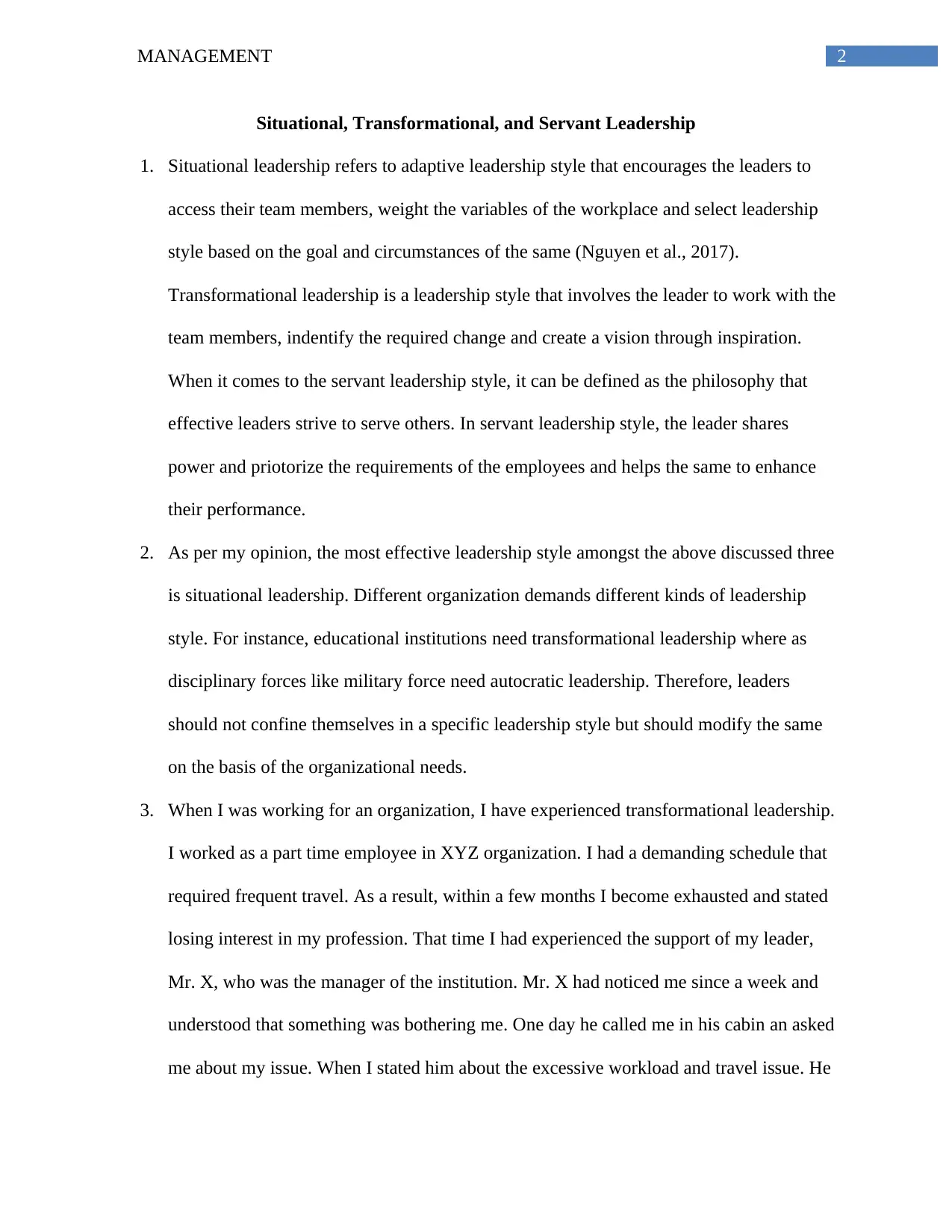
2MANAGEMENT
Situational, Transformational, and Servant Leadership
1. Situational leadership refers to adaptive leadership style that encourages the leaders to
access their team members, weight the variables of the workplace and select leadership
style based on the goal and circumstances of the same (Nguyen et al., 2017).
Transformational leadership is a leadership style that involves the leader to work with the
team members, indentify the required change and create a vision through inspiration.
When it comes to the servant leadership style, it can be defined as the philosophy that
effective leaders strive to serve others. In servant leadership style, the leader shares
power and priotorize the requirements of the employees and helps the same to enhance
their performance.
2. As per my opinion, the most effective leadership style amongst the above discussed three
is situational leadership. Different organization demands different kinds of leadership
style. For instance, educational institutions need transformational leadership where as
disciplinary forces like military force need autocratic leadership. Therefore, leaders
should not confine themselves in a specific leadership style but should modify the same
on the basis of the organizational needs.
3. When I was working for an organization, I have experienced transformational leadership.
I worked as a part time employee in XYZ organization. I had a demanding schedule that
required frequent travel. As a result, within a few months I become exhausted and stated
losing interest in my profession. That time I had experienced the support of my leader,
Mr. X, who was the manager of the institution. Mr. X had noticed me since a week and
understood that something was bothering me. One day he called me in his cabin an asked
me about my issue. When I stated him about the excessive workload and travel issue. He
Situational, Transformational, and Servant Leadership
1. Situational leadership refers to adaptive leadership style that encourages the leaders to
access their team members, weight the variables of the workplace and select leadership
style based on the goal and circumstances of the same (Nguyen et al., 2017).
Transformational leadership is a leadership style that involves the leader to work with the
team members, indentify the required change and create a vision through inspiration.
When it comes to the servant leadership style, it can be defined as the philosophy that
effective leaders strive to serve others. In servant leadership style, the leader shares
power and priotorize the requirements of the employees and helps the same to enhance
their performance.
2. As per my opinion, the most effective leadership style amongst the above discussed three
is situational leadership. Different organization demands different kinds of leadership
style. For instance, educational institutions need transformational leadership where as
disciplinary forces like military force need autocratic leadership. Therefore, leaders
should not confine themselves in a specific leadership style but should modify the same
on the basis of the organizational needs.
3. When I was working for an organization, I have experienced transformational leadership.
I worked as a part time employee in XYZ organization. I had a demanding schedule that
required frequent travel. As a result, within a few months I become exhausted and stated
losing interest in my profession. That time I had experienced the support of my leader,
Mr. X, who was the manager of the institution. Mr. X had noticed me since a week and
understood that something was bothering me. One day he called me in his cabin an asked
me about my issue. When I stated him about the excessive workload and travel issue. He
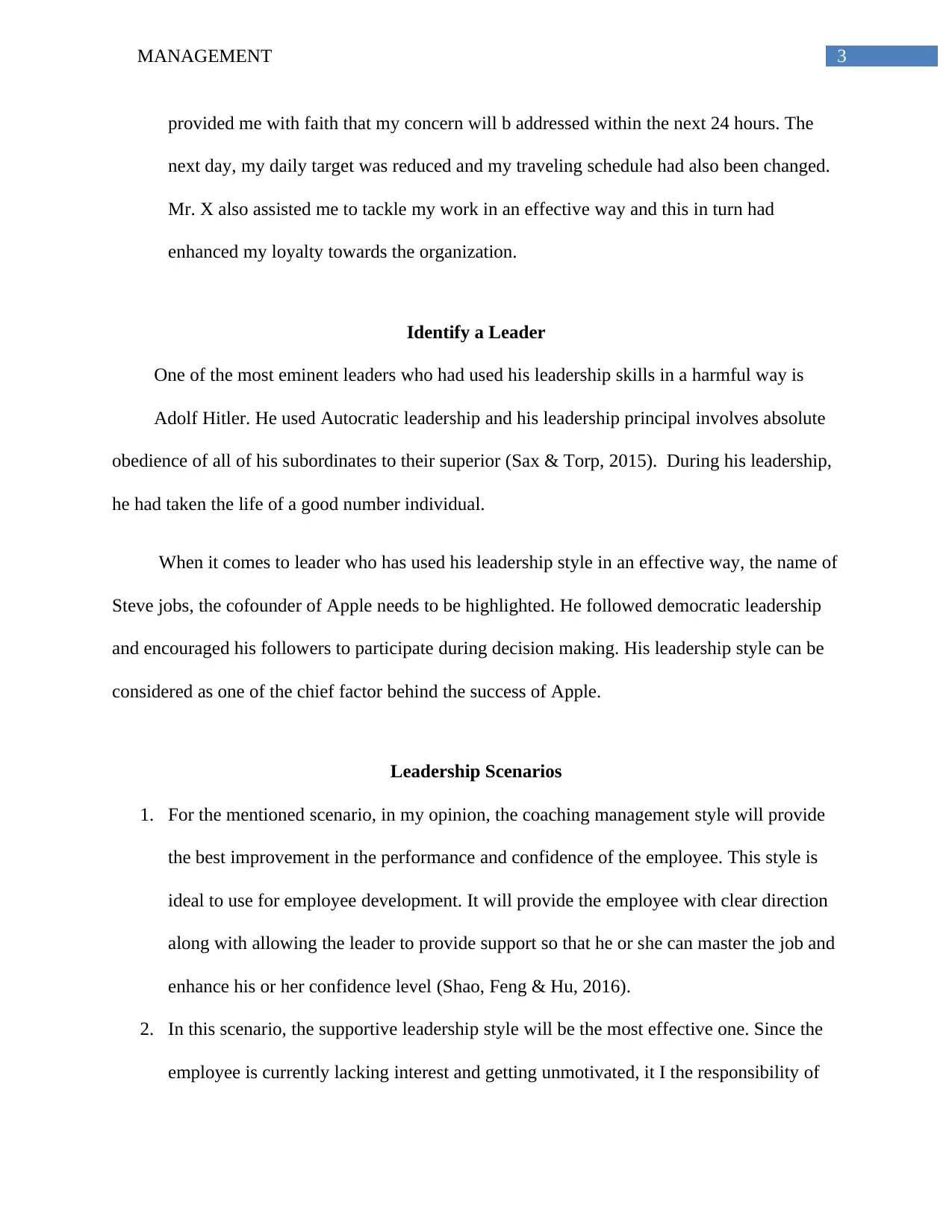
3MANAGEMENT
provided me with faith that my concern will b addressed within the next 24 hours. The
next day, my daily target was reduced and my traveling schedule had also been changed.
Mr. X also assisted me to tackle my work in an effective way and this in turn had
enhanced my loyalty towards the organization.
Identify a Leader
One of the most eminent leaders who had used his leadership skills in a harmful way is
Adolf Hitler. He used Autocratic leadership and his leadership principal involves absolute
obedience of all of his subordinates to their superior (Sax & Torp, 2015). During his leadership,
he had taken the life of a good number individual.
When it comes to leader who has used his leadership style in an effective way, the name of
Steve jobs, the cofounder of Apple needs to be highlighted. He followed democratic leadership
and encouraged his followers to participate during decision making. His leadership style can be
considered as one of the chief factor behind the success of Apple.
Leadership Scenarios
1. For the mentioned scenario, in my opinion, the coaching management style will provide
the best improvement in the performance and confidence of the employee. This style is
ideal to use for employee development. It will provide the employee with clear direction
along with allowing the leader to provide support so that he or she can master the job and
enhance his or her confidence level (Shao, Feng & Hu, 2016).
2. In this scenario, the supportive leadership style will be the most effective one. Since the
employee is currently lacking interest and getting unmotivated, it I the responsibility of
provided me with faith that my concern will b addressed within the next 24 hours. The
next day, my daily target was reduced and my traveling schedule had also been changed.
Mr. X also assisted me to tackle my work in an effective way and this in turn had
enhanced my loyalty towards the organization.
Identify a Leader
One of the most eminent leaders who had used his leadership skills in a harmful way is
Adolf Hitler. He used Autocratic leadership and his leadership principal involves absolute
obedience of all of his subordinates to their superior (Sax & Torp, 2015). During his leadership,
he had taken the life of a good number individual.
When it comes to leader who has used his leadership style in an effective way, the name of
Steve jobs, the cofounder of Apple needs to be highlighted. He followed democratic leadership
and encouraged his followers to participate during decision making. His leadership style can be
considered as one of the chief factor behind the success of Apple.
Leadership Scenarios
1. For the mentioned scenario, in my opinion, the coaching management style will provide
the best improvement in the performance and confidence of the employee. This style is
ideal to use for employee development. It will provide the employee with clear direction
along with allowing the leader to provide support so that he or she can master the job and
enhance his or her confidence level (Shao, Feng & Hu, 2016).
2. In this scenario, the supportive leadership style will be the most effective one. Since the
employee is currently lacking interest and getting unmotivated, it I the responsibility of
Secure Best Marks with AI Grader
Need help grading? Try our AI Grader for instant feedback on your assignments.
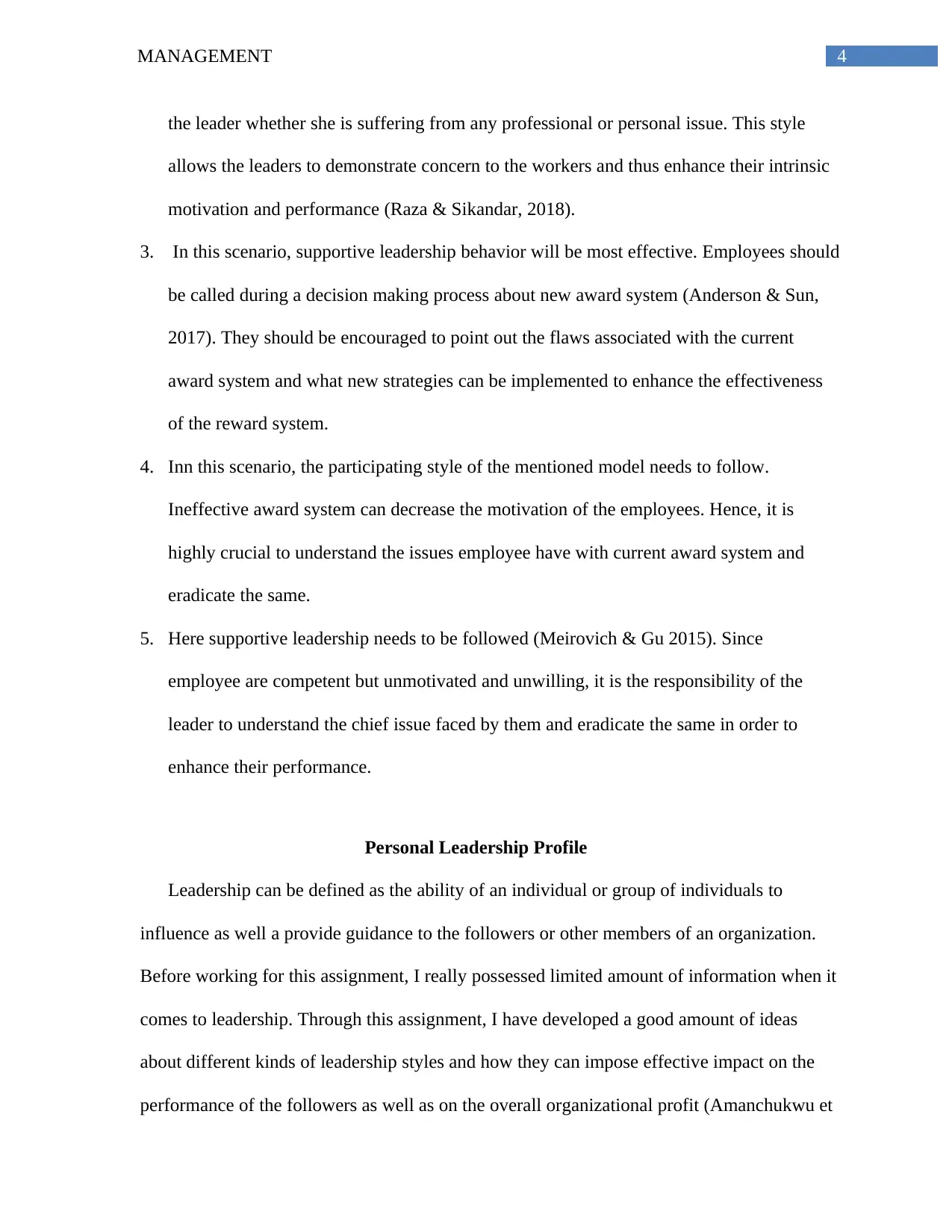
4MANAGEMENT
the leader whether she is suffering from any professional or personal issue. This style
allows the leaders to demonstrate concern to the workers and thus enhance their intrinsic
motivation and performance (Raza & Sikandar, 2018).
3. In this scenario, supportive leadership behavior will be most effective. Employees should
be called during a decision making process about new award system (Anderson & Sun,
2017). They should be encouraged to point out the flaws associated with the current
award system and what new strategies can be implemented to enhance the effectiveness
of the reward system.
4. Inn this scenario, the participating style of the mentioned model needs to follow.
Ineffective award system can decrease the motivation of the employees. Hence, it is
highly crucial to understand the issues employee have with current award system and
eradicate the same.
5. Here supportive leadership needs to be followed (Meirovich & Gu 2015). Since
employee are competent but unmotivated and unwilling, it is the responsibility of the
leader to understand the chief issue faced by them and eradicate the same in order to
enhance their performance.
Personal Leadership Profile
Leadership can be defined as the ability of an individual or group of individuals to
influence as well a provide guidance to the followers or other members of an organization.
Before working for this assignment, I really possessed limited amount of information when it
comes to leadership. Through this assignment, I have developed a good amount of ideas
about different kinds of leadership styles and how they can impose effective impact on the
performance of the followers as well as on the overall organizational profit (Amanchukwu et
the leader whether she is suffering from any professional or personal issue. This style
allows the leaders to demonstrate concern to the workers and thus enhance their intrinsic
motivation and performance (Raza & Sikandar, 2018).
3. In this scenario, supportive leadership behavior will be most effective. Employees should
be called during a decision making process about new award system (Anderson & Sun,
2017). They should be encouraged to point out the flaws associated with the current
award system and what new strategies can be implemented to enhance the effectiveness
of the reward system.
4. Inn this scenario, the participating style of the mentioned model needs to follow.
Ineffective award system can decrease the motivation of the employees. Hence, it is
highly crucial to understand the issues employee have with current award system and
eradicate the same.
5. Here supportive leadership needs to be followed (Meirovich & Gu 2015). Since
employee are competent but unmotivated and unwilling, it is the responsibility of the
leader to understand the chief issue faced by them and eradicate the same in order to
enhance their performance.
Personal Leadership Profile
Leadership can be defined as the ability of an individual or group of individuals to
influence as well a provide guidance to the followers or other members of an organization.
Before working for this assignment, I really possessed limited amount of information when it
comes to leadership. Through this assignment, I have developed a good amount of ideas
about different kinds of leadership styles and how they can impose effective impact on the
performance of the followers as well as on the overall organizational profit (Amanchukwu et
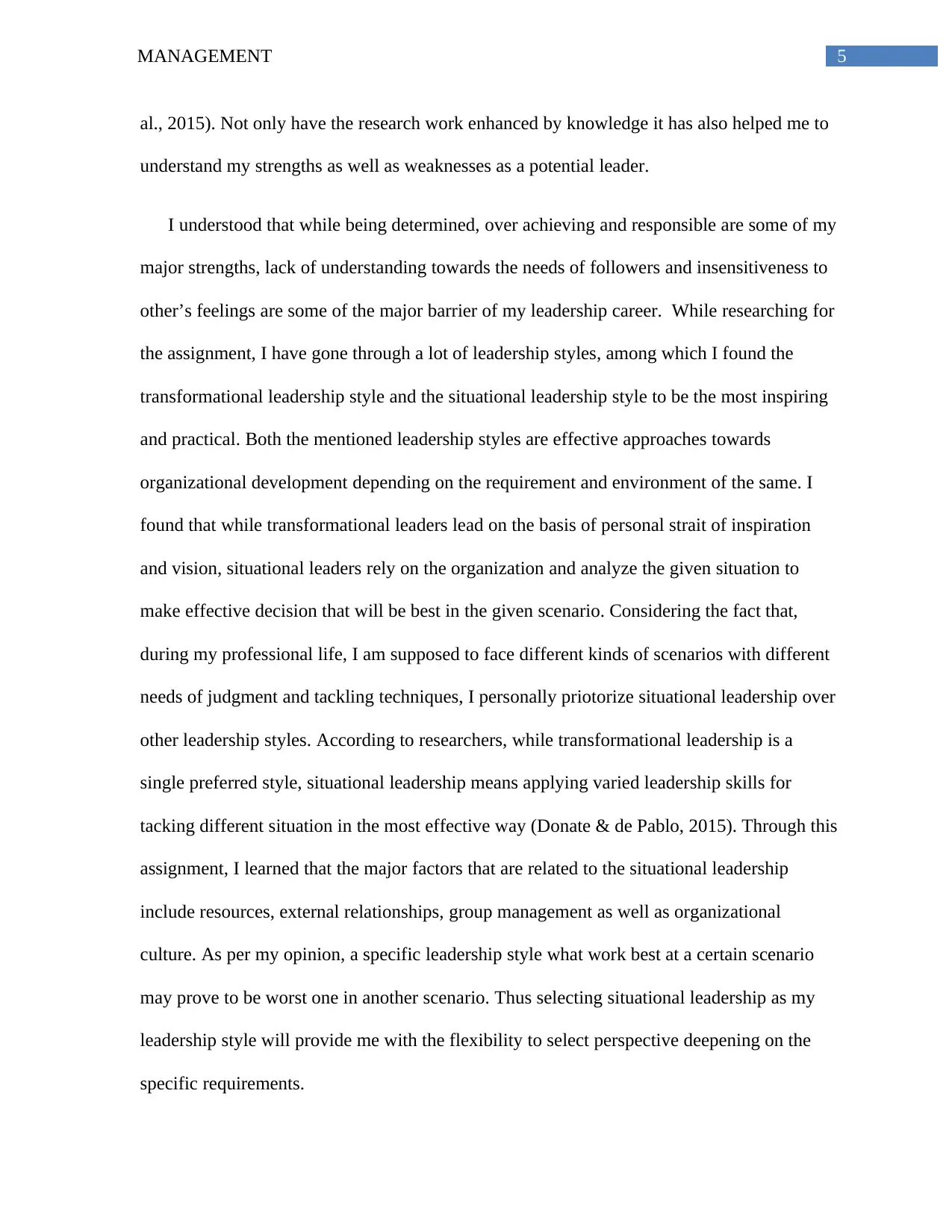
5MANAGEMENT
al., 2015). Not only have the research work enhanced by knowledge it has also helped me to
understand my strengths as well as weaknesses as a potential leader.
I understood that while being determined, over achieving and responsible are some of my
major strengths, lack of understanding towards the needs of followers and insensitiveness to
other’s feelings are some of the major barrier of my leadership career. While researching for
the assignment, I have gone through a lot of leadership styles, among which I found the
transformational leadership style and the situational leadership style to be the most inspiring
and practical. Both the mentioned leadership styles are effective approaches towards
organizational development depending on the requirement and environment of the same. I
found that while transformational leaders lead on the basis of personal strait of inspiration
and vision, situational leaders rely on the organization and analyze the given situation to
make effective decision that will be best in the given scenario. Considering the fact that,
during my professional life, I am supposed to face different kinds of scenarios with different
needs of judgment and tackling techniques, I personally priotorize situational leadership over
other leadership styles. According to researchers, while transformational leadership is a
single preferred style, situational leadership means applying varied leadership skills for
tacking different situation in the most effective way (Donate & de Pablo, 2015). Through this
assignment, I learned that the major factors that are related to the situational leadership
include resources, external relationships, group management as well as organizational
culture. As per my opinion, a specific leadership style what work best at a certain scenario
may prove to be worst one in another scenario. Thus selecting situational leadership as my
leadership style will provide me with the flexibility to select perspective deepening on the
specific requirements.
al., 2015). Not only have the research work enhanced by knowledge it has also helped me to
understand my strengths as well as weaknesses as a potential leader.
I understood that while being determined, over achieving and responsible are some of my
major strengths, lack of understanding towards the needs of followers and insensitiveness to
other’s feelings are some of the major barrier of my leadership career. While researching for
the assignment, I have gone through a lot of leadership styles, among which I found the
transformational leadership style and the situational leadership style to be the most inspiring
and practical. Both the mentioned leadership styles are effective approaches towards
organizational development depending on the requirement and environment of the same. I
found that while transformational leaders lead on the basis of personal strait of inspiration
and vision, situational leaders rely on the organization and analyze the given situation to
make effective decision that will be best in the given scenario. Considering the fact that,
during my professional life, I am supposed to face different kinds of scenarios with different
needs of judgment and tackling techniques, I personally priotorize situational leadership over
other leadership styles. According to researchers, while transformational leadership is a
single preferred style, situational leadership means applying varied leadership skills for
tacking different situation in the most effective way (Donate & de Pablo, 2015). Through this
assignment, I learned that the major factors that are related to the situational leadership
include resources, external relationships, group management as well as organizational
culture. As per my opinion, a specific leadership style what work best at a certain scenario
may prove to be worst one in another scenario. Thus selecting situational leadership as my
leadership style will provide me with the flexibility to select perspective deepening on the
specific requirements.
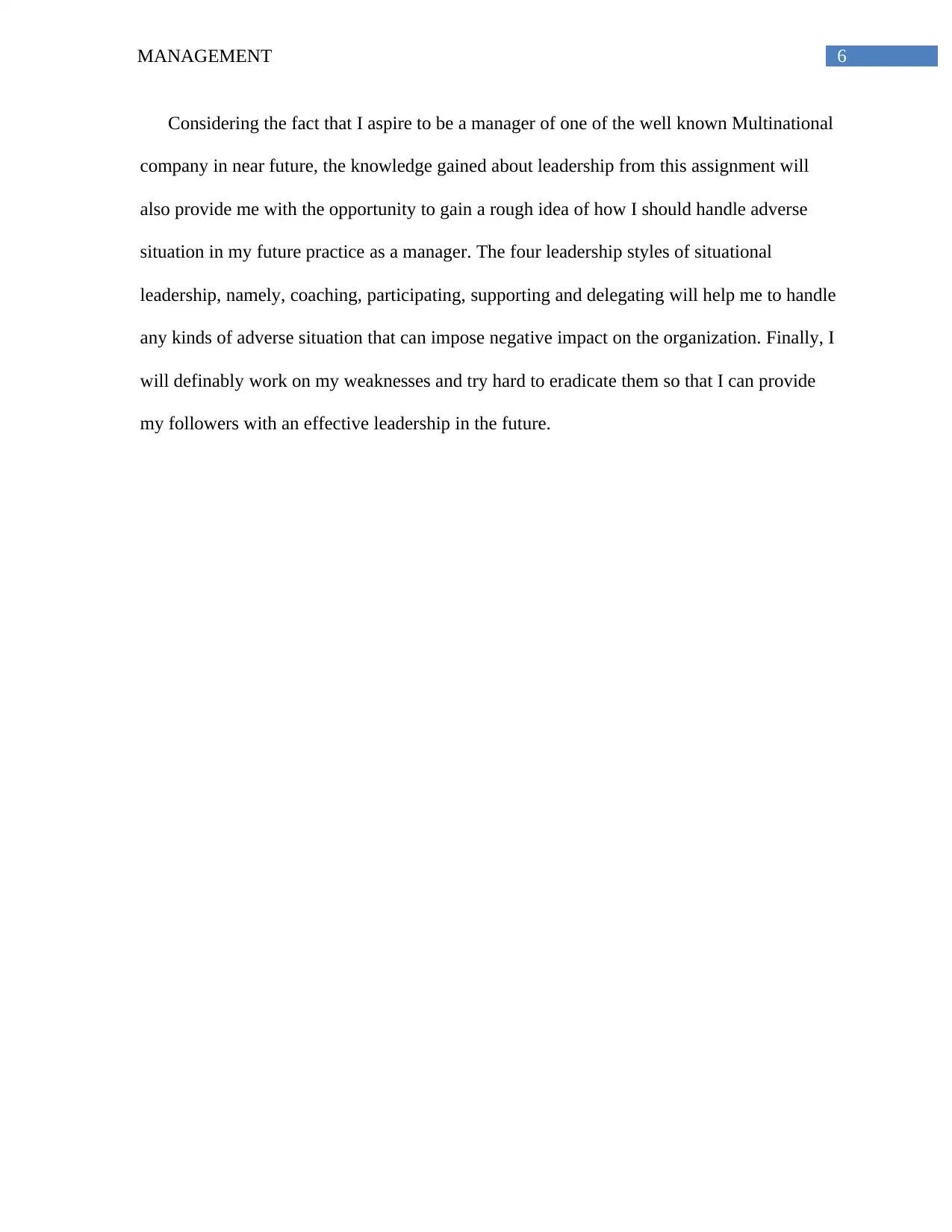
6MANAGEMENT
Considering the fact that I aspire to be a manager of one of the well known Multinational
company in near future, the knowledge gained about leadership from this assignment will
also provide me with the opportunity to gain a rough idea of how I should handle adverse
situation in my future practice as a manager. The four leadership styles of situational
leadership, namely, coaching, participating, supporting and delegating will help me to handle
any kinds of adverse situation that can impose negative impact on the organization. Finally, I
will definably work on my weaknesses and try hard to eradicate them so that I can provide
my followers with an effective leadership in the future.
Considering the fact that I aspire to be a manager of one of the well known Multinational
company in near future, the knowledge gained about leadership from this assignment will
also provide me with the opportunity to gain a rough idea of how I should handle adverse
situation in my future practice as a manager. The four leadership styles of situational
leadership, namely, coaching, participating, supporting and delegating will help me to handle
any kinds of adverse situation that can impose negative impact on the organization. Finally, I
will definably work on my weaknesses and try hard to eradicate them so that I can provide
my followers with an effective leadership in the future.
Paraphrase This Document
Need a fresh take? Get an instant paraphrase of this document with our AI Paraphraser
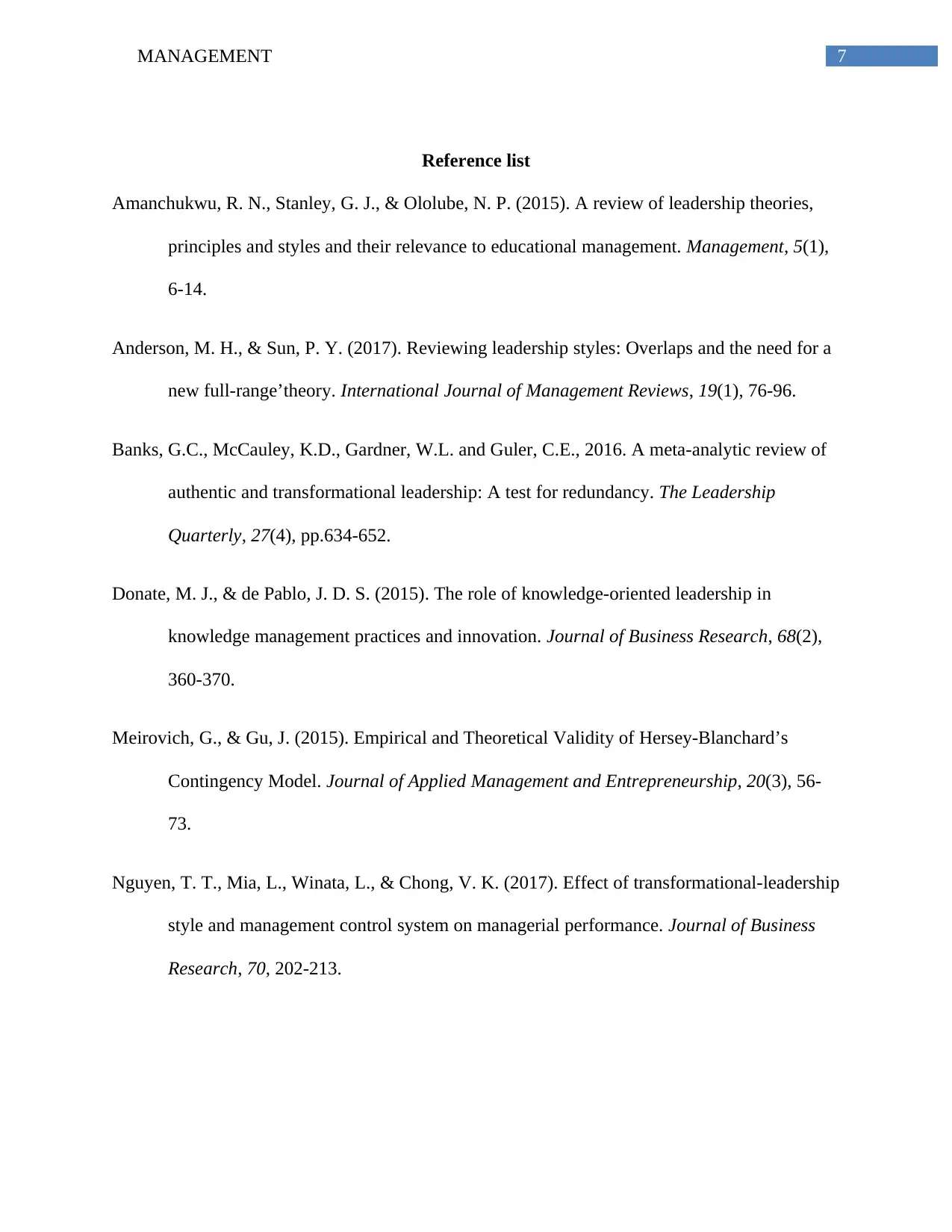
7MANAGEMENT
Reference list
Amanchukwu, R. N., Stanley, G. J., & Ololube, N. P. (2015). A review of leadership theories,
principles and styles and their relevance to educational management. Management, 5(1),
6-14.
Anderson, M. H., & Sun, P. Y. (2017). Reviewing leadership styles: Overlaps and the need for a
new full‐range’theory. International Journal of Management Reviews, 19(1), 76-96.
Banks, G.C., McCauley, K.D., Gardner, W.L. and Guler, C.E., 2016. A meta-analytic review of
authentic and transformational leadership: A test for redundancy. The Leadership
Quarterly, 27(4), pp.634-652.
Donate, M. J., & de Pablo, J. D. S. (2015). The role of knowledge-oriented leadership in
knowledge management practices and innovation. Journal of Business Research, 68(2),
360-370.
Meirovich, G., & Gu, J. (2015). Empirical and Theoretical Validity of Hersey-Blanchard’s
Contingency Model. Journal of Applied Management and Entrepreneurship, 20(3), 56-
73.
Nguyen, T. T., Mia, L., Winata, L., & Chong, V. K. (2017). Effect of transformational-leadership
style and management control system on managerial performance. Journal of Business
Research, 70, 202-213.
Reference list
Amanchukwu, R. N., Stanley, G. J., & Ololube, N. P. (2015). A review of leadership theories,
principles and styles and their relevance to educational management. Management, 5(1),
6-14.
Anderson, M. H., & Sun, P. Y. (2017). Reviewing leadership styles: Overlaps and the need for a
new full‐range’theory. International Journal of Management Reviews, 19(1), 76-96.
Banks, G.C., McCauley, K.D., Gardner, W.L. and Guler, C.E., 2016. A meta-analytic review of
authentic and transformational leadership: A test for redundancy. The Leadership
Quarterly, 27(4), pp.634-652.
Donate, M. J., & de Pablo, J. D. S. (2015). The role of knowledge-oriented leadership in
knowledge management practices and innovation. Journal of Business Research, 68(2),
360-370.
Meirovich, G., & Gu, J. (2015). Empirical and Theoretical Validity of Hersey-Blanchard’s
Contingency Model. Journal of Applied Management and Entrepreneurship, 20(3), 56-
73.
Nguyen, T. T., Mia, L., Winata, L., & Chong, V. K. (2017). Effect of transformational-leadership
style and management control system on managerial performance. Journal of Business
Research, 70, 202-213.
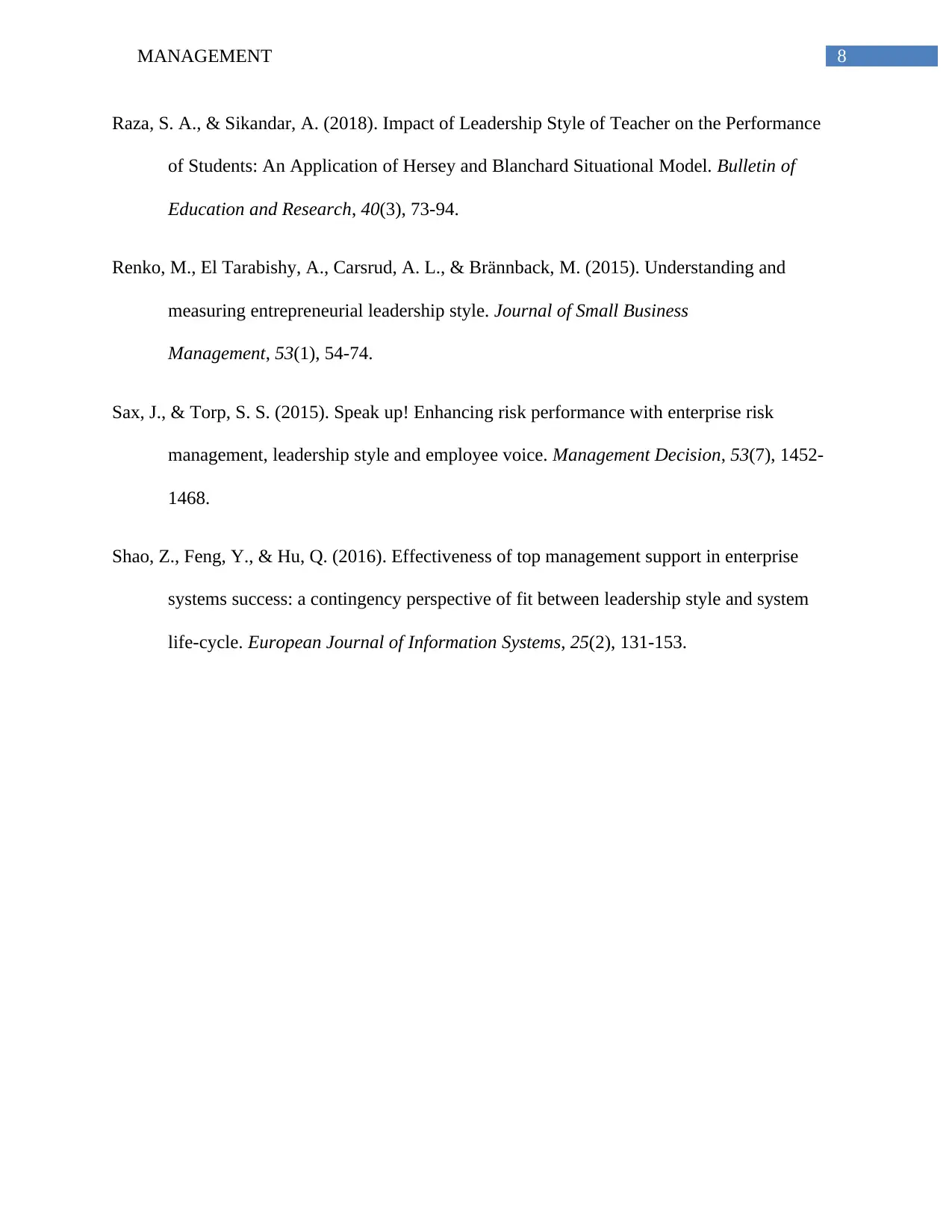
8MANAGEMENT
Raza, S. A., & Sikandar, A. (2018). Impact of Leadership Style of Teacher on the Performance
of Students: An Application of Hersey and Blanchard Situational Model. Bulletin of
Education and Research, 40(3), 73-94.
Renko, M., El Tarabishy, A., Carsrud, A. L., & Brännback, M. (2015). Understanding and
measuring entrepreneurial leadership style. Journal of Small Business
Management, 53(1), 54-74.
Sax, J., & Torp, S. S. (2015). Speak up! Enhancing risk performance with enterprise risk
management, leadership style and employee voice. Management Decision, 53(7), 1452-
1468.
Shao, Z., Feng, Y., & Hu, Q. (2016). Effectiveness of top management support in enterprise
systems success: a contingency perspective of fit between leadership style and system
life-cycle. European Journal of Information Systems, 25(2), 131-153.
Raza, S. A., & Sikandar, A. (2018). Impact of Leadership Style of Teacher on the Performance
of Students: An Application of Hersey and Blanchard Situational Model. Bulletin of
Education and Research, 40(3), 73-94.
Renko, M., El Tarabishy, A., Carsrud, A. L., & Brännback, M. (2015). Understanding and
measuring entrepreneurial leadership style. Journal of Small Business
Management, 53(1), 54-74.
Sax, J., & Torp, S. S. (2015). Speak up! Enhancing risk performance with enterprise risk
management, leadership style and employee voice. Management Decision, 53(7), 1452-
1468.
Shao, Z., Feng, Y., & Hu, Q. (2016). Effectiveness of top management support in enterprise
systems success: a contingency perspective of fit between leadership style and system
life-cycle. European Journal of Information Systems, 25(2), 131-153.
1 out of 9
Related Documents
Your All-in-One AI-Powered Toolkit for Academic Success.
+13062052269
info@desklib.com
Available 24*7 on WhatsApp / Email
![[object Object]](/_next/static/media/star-bottom.7253800d.svg)
Unlock your academic potential
© 2024 | Zucol Services PVT LTD | All rights reserved.





